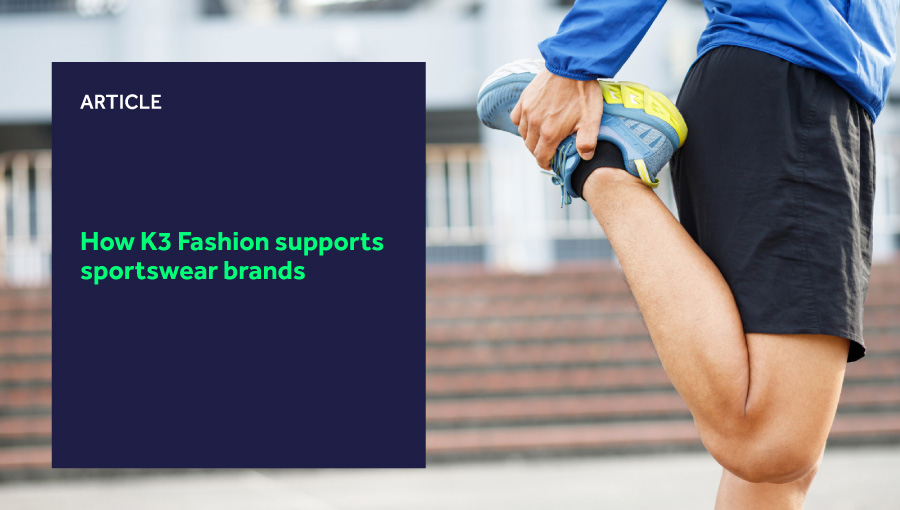Fashion – it’s all the same at its core, right? Nope. The industry has many facets with sub-industries, like sportswear, with specific needs and challenges that must be overcome.
Sportswear is a growing industry. McKinsey data shows that two-thirds of Millennials and Gen Z wear athleisure multiple times per week while sports tourism is set to grow 18% by 2030.
All this leads to challenger sportswear brands growing, on average, 18% annually – compared to just 4% for incumbents.
As these newer brands grow, their challenges will only increase, underscoring the need for the right solution to support them.
Material limitations and technical constraints
The sportswear industry operates in a uniquely demanding environment. Each garment must:
- Withstand intense physical stress
- Provide superior athlete performance
- Maintain comfort across varied conditions
- Meet increasingly sophisticated consumer expectations
These requirements create a production ecosystem far more complex than traditional fashion and demand an ERP that can support these nuances.
Different seasonal dynamics
Traditional fashion operates on quick, frequent collection cycles. Sportswear follows a dramatically different pattern:
- Longer lead times for product development
- More extended sales periods for key collections
- Complex wholesale models with potential for customisation
- Ability to accommodate last-minute changes for key clients and athletes
The difference in seasonal planning means that sportswear brands often start planning their collections significantly earlier than in traditional fashion cycles.
Brands must simultaneously plan for immediate market needs and long-term technological innovations… something that isn’t easy to do without an appropriate system to track and manage everything.
Sportswear predominantly relies on wholesale sales
While the likes of Shein and Temu operate on a pureplay direct-to-consumer model, sportswear brands sit on the polar opposite end of the spectrum.
Today, it is more common to see a retail presence from sportswear brands, but generally speaking, these businesses wholly rely on wholesale channels. This means:
- Managing intricate relationships with key retailers
- Balancing limited production runs
- Providing flexibility for important clients
- Ensuring consistent product quality across varied distribution channels
Again, to ensure proper planning, communication and coordination, sportswear brands need a robust ERP environment to house data and relay information to suppliers and clients.
Bridging innovation and operations with tech
As mentioned, the above challenges necessitate technology that allows sportswear brands to handle everything in one place.
This means departments all work from the same data and playbook, enabling them to:
- Track complex product lifecycles
- Manage multi-channel sales strategies
- Provide real-time inventory insights
- Support rapid innovation cycles
So, where does one find a solution that can achieve all this? We’re glad you asked…
How K3 Fashion can help
Our K3 Fashion solution, embedded in Dynamics 365 Finance, Supply Chain Management and Commerce, is purpose-built to support sportswear brands with their challenges.
With K3 Fashion, sportswear brands can plan for their wholesale, retail, and online businesses separately (i.e., in silos), ensuring they can separate stock per each business channel.
At the same time, K3 Fashion only siloes the stock systemically, meaning the stock in the warehouse is available across all channels.
Additionally, K3 Fashion has ringfencing functionality to ensure that certain products or product quantities can be secured for special customers or groups (e.g., buying groups).
The ringfencing feature can also be utilised to ensure goods are only made available for specific customers, supporting special programmes with customers.
Finally, K3 Fashion’s channel management and prioritisation functionality enables sportswear brands to efficiently deal with key customers’ eCommerce platforms and retail stores while also keeping stock available for important clients across their individual channels.
This further ensures that key customers, stores, and platforms always receive their goods when needed.
Want to know more?
Sportswear brands don’t need just any ERP, they need a tailored solution like K3 Fashion.
While ERPs, on the whole, are pretty powerful, they lack the nuance that sportswear demands.
If you’re a sportswear brand ready to take the next step in your ERP journey, we’d love to talk. So, feel free to drop us a line today.
 https://k3fashionsolutions.com/wp-content/uploads/2025/05/konges-case-study-featured.jpg
510
900
Jordan Heal
https://k3fashionsolutions.com/wp-content/uploads/2024/12/K3_Fashion_Solutions_Half-color_RGB.svg
Jordan Heal2025-05-07 10:05:062025-06-09 11:45:34Elbek & Vejrup sets Konges Sløjd up for further growth with D365 BC and K3 Pebblestone
https://k3fashionsolutions.com/wp-content/uploads/2025/05/konges-case-study-featured.jpg
510
900
Jordan Heal
https://k3fashionsolutions.com/wp-content/uploads/2024/12/K3_Fashion_Solutions_Half-color_RGB.svg
Jordan Heal2025-05-07 10:05:062025-06-09 11:45:34Elbek & Vejrup sets Konges Sløjd up for further growth with D365 BC and K3 Pebblestone


